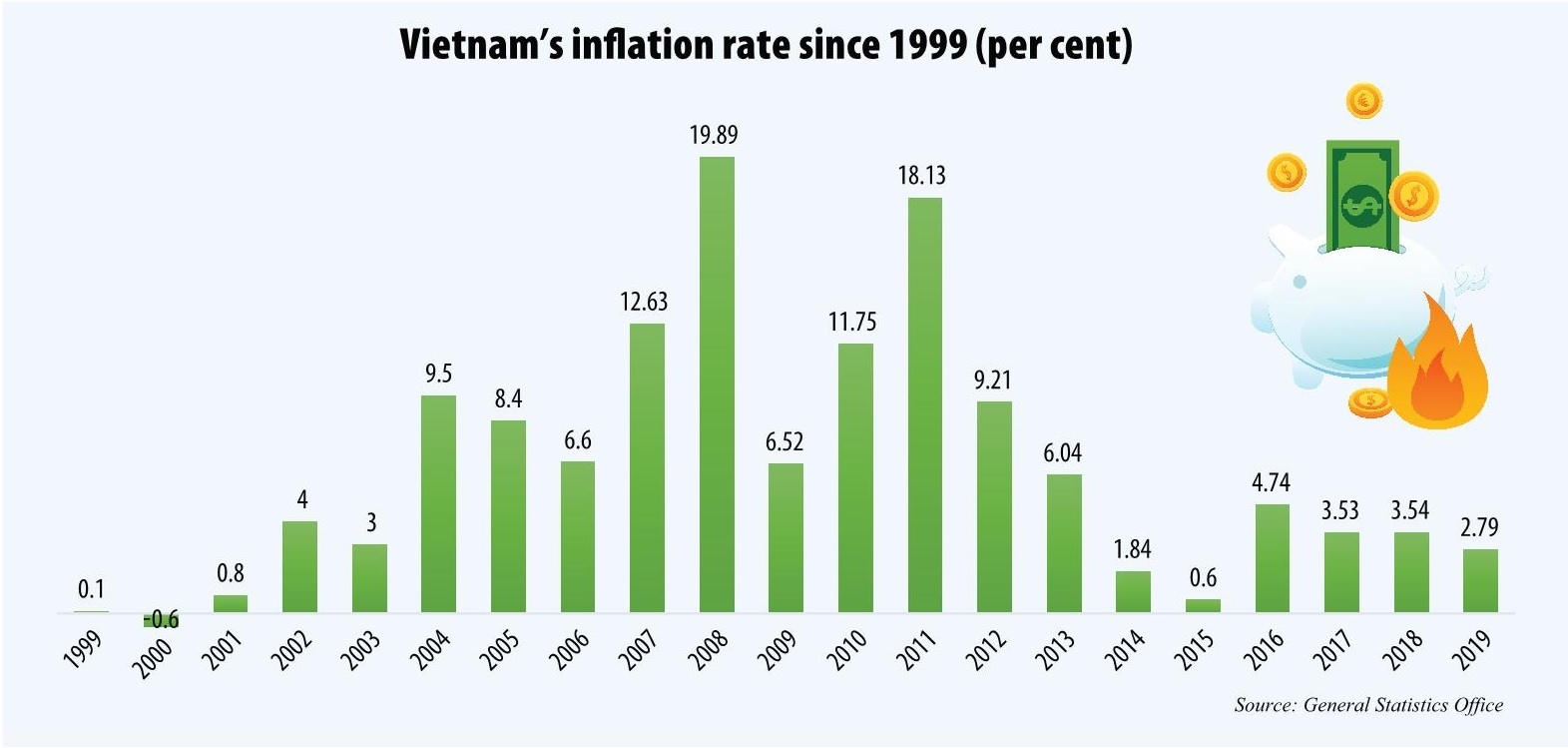2020 inflation rate rides on outbreak eventualities
 |
Dang Duc Anh, vice director of the National Centre for Socio-Economic Information and Forecast (NCIF), told VIR that if the COVID-19 outbreak continues until the second quarter of this year, it will be “very hard” for the government to keep the inflation rate for the whole year under 4 per cent as hoped.
“The epidemic will drive prices of goods and services up strongly in the global market, while Vietnam’s industrial production largely depends on material imports such as electronics, textiles and garments, and footwear,” Anh said. “Meanwhile, prices of these items are uncertain. Shortages often lead to high prices.”
Currently, all domestic and foreign enterprises in the industries of textiles and garments, electronics, automobiles, and pesticides are facing tough times due to a shortage of materials, 30-60 per cent of which are imported from China.
In January, the NCIF forecast that Vietnam’s 2020 inflation rate will be about 3.2 per cent.
“However, we will have to revise this because everything has changed due to COVID-19. Our new inflation forecast for 2020 may be at least 4 per cent,” Anh said.
The Ministry of Planning and Investment’s (MPI) latest scenarios also show that the COVID-19 will make it an uphill battle to control inflation below 4 per cent this year.
If the outbreak is fully controlled by the end of the first quarter, if the price of fuel does not rise, and if education service costs increase in accordance with the government’s roadmap, the inflation rate for 2020 will be 3.96 per cent.
However, if the epidemic is quelled at the end of the first quarter or even in the second quarter, but if there is an average 10 per cent increase in price of pork, a climb of 5 per cent in fuel costs, and a rise of 10 per cent in gas price – in addition to negative impacts of droughts and water shortages for production – the inflation rate for the year will ascend 4.86 per cent.
“Effects of the epidemic will increase the prices of household-oriented water, healthcare services, and electricity,” said an MPI report on the impacts of COVID-19 on the domestic economy. “If the outbreak continues until the second quarter, prices of fresh foodstuff will sharply increase due to shrunken production activities, and notably they will move up strongly during the remaining months of the year.”
The Asian Development Bank and the World Bank are now reassessing Vietnam’s economic performance, and will soon release fresh evaluations of the country’s inflation rate for 2020. Previously, both banks forecast that the rates would be 3.5 and 3.3 per cent, respectively.
However, with the economy negatively impacted by COVID-19, it is expected that the lenders will adjust the inflation rate for Vietnam this year.
For February and the first two months, the average on-year consumer price index (CPI) rose 5.91 per cent, recording a seven-year high as compared to the same periods since 2013, according to the General Statistics Office.
The office said such a high CPI will “threaten efforts” from the government to keep inflation below 4 per cent this year. It has also proposed that the government refrain from increasing the electricity price in order to support local production and people’s livelihoods. However, experts said that even with no such plan, demand for electricity is still high for production and consumption, which will in turn increase the CPI.
Vietnam’s inflation rate last year increased 2.79 per cent on-year.
What the stars mean:
★ Poor ★ ★ Promising ★★★ Good ★★★★ Very good ★★★★★ Exceptional
Themes: COVID-19
- 67 million children missed out on vaccines because of Covid: UNICEF
- Vietnam records 305 COVID-19 cases on October 30
- 671 new COVID-19 cases recorded on October 1
- Vietnam logs additional 2,287 COVID-19 cases on Sept. 21
- People’s support decisive to vaccination coverage expansion: official
Related Contents
Latest News
More News
- Vietnam’s green transition demands collective financial action (December 15, 2025 | 12:00)
- VIR workshop highlights capital and policy for sustainable development (December 15, 2025 | 11:00)
- National Assembly approves pilot mechanisms to accelerate major projects in Hanoi (December 12, 2025 | 11:29)
- Vietnam eases policy approval requirements, simplifies foreign and outbound investments (December 11, 2025 | 17:53)
- Unpacking new momentum in Vietnam’s M&A market (December 10, 2025 | 09:59)
- Forum honours outstanding M&A deals, strategies, and advisory firms (December 09, 2025 | 18:22)
- Vietnam enters defining phase of M&A growth (December 09, 2025 | 17:00)
- Vietnam’s M&A market opens new opportunities amid strong economic momentum (December 09, 2025 | 15:00)
- Vietnam M&A Forum 2025: new position, new momentum (December 09, 2025 | 14:30)
- FDI in Vietnam jumps on additional capital and share purchases (December 09, 2025 | 13:56)

 Tag:
Tag:






















 Mobile Version
Mobile Version